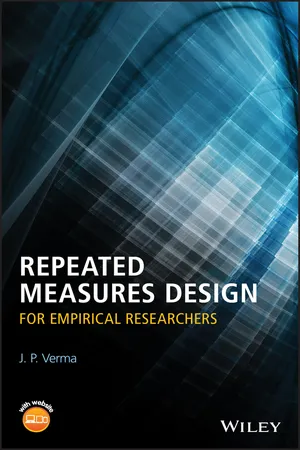
- English
- ePUB (mobile friendly)
- Available on iOS & Android
Repeated Measures Design for Empirical Researchers
About this book
Introduces the applications of repeated measures design processes with the popular IBM® SPSS® software
Repeated Measures Design for Empirical Researchers presents comprehensive coverage of the formation of research questions and the analysis of repeated measures using IBM SPSS and also includes the solutions necessary for understanding situations where the designs can be used. In addition to explaining the computation involved in each design, the book presents a unique discussion on how to conceptualize research problems as well as identify appropriate repeated measures designs for research purposes.
Featuring practical examples from a multitude of domains including psychology, the social sciences, management, and sports science, the book helps readers better understand the associated theories and methodologies of repeated measures design processes. The book covers various fundamental concepts involved in the design of experiments, basic statistical designs, computational details, differentiating independent and repeated measures designs, and testing assumptions. Along with an introduction to IBM SPSS software, Repeated Measures Design for Empirical Researchers includes:
- A discussion of the popular repeated measures designs frequently used by researchers, such as one-way repeated measures ANOVA, two-way repeated measures design, two-way mixed design, and mixed design with two-way MANOVA
- Coverage of sample size determination for the successful implementation of designing and analyzing a repeated measures study
- A step-by-step guide to analyzing the data obtained with real-world examples throughout to illustrate the underlying advantages and assumptions
- A companion website with supplementary IBM SPSS data sets and programming solutions as well as additional case studies
Repeated Measures Design for Empirical Researchers is a useful textbook for graduate- and PhD-level students majoring in biostatistics, the social sciences, psychology, medicine, management, sports, physical education, and health. The book is also an excellent reference for professionals interested in experimental designs and statistical sciences as well as statistical consultants and practitioners from other fields including biological, medical, agricultural, and horticultural sciences.
J. P. Verma, PhD, is Professor of Statistics and Director of the Center for Advanced Studies at Lakshmibai National Institute of Physical Education, India. Professor Verma is an active researcher in sports modeling and data analysis and has conducted many workshops on research methodology, research designs, multivariate analysis, statistical modeling, and data analysis for students of management, physical education, social science, and economics. He is the author of Statistics for Exercise Science and Health with Microsoft® Office Excel®, also published by Wiley.
Frequently asked questions
- Essential is ideal for learners and professionals who enjoy exploring a wide range of subjects. Access the Essential Library with 800,000+ trusted titles and best-sellers across business, personal growth, and the humanities. Includes unlimited reading time and Standard Read Aloud voice.
- Complete: Perfect for advanced learners and researchers needing full, unrestricted access. Unlock 1.4M+ books across hundreds of subjects, including academic and specialized titles. The Complete Plan also includes advanced features like Premium Read Aloud and Research Assistant.
Please note we cannot support devices running on iOS 13 and Android 7 or earlier. Learn more about using the app.
Information
Chapter 1
Foundations of Experimental Design
Introduction
What is Experimental Research?
Design of Experiment and its Principles
Randomization
Table of contents
- Cover
- Title Page
- Copyright
- Table of Contents
- Dedication
- Preface
- Illustration Credits
- Chapter 1: Foundations of Experimental Design
- Chapter 2: Analysis of Variance and Repeated Measures Design
- Chapter 3: Testing Assumptions in Repeated Measures Design Using SPSS
- Chapter 4: One-Way Repeated Measures Design
- Chapter 5: Two-Way Repeated Measures Design
- Chapter 6: Two-Way Mixed Design
- Chapter 7: One-Way Repeated Measures Manova
- Chapter 8: Mixed Design with Two-Way Manova
- Appendix
- Index
- End User License Agreement